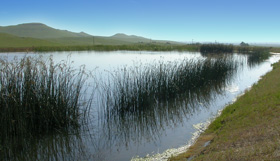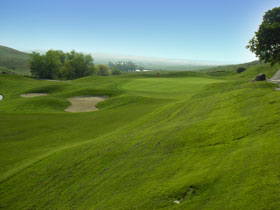- What is recycled water?
- Why should we reuse water?
- How is water recycled?
- Who develops the health standards for recycled water?
- How does recycled water irrigation affect landscaped areas?
- What measures can be utilized to minimize the impact of a water recycling plant on the adjacent property?
- What can recycled water be used for?
- What do you do with recycled water during wet weather?
- Odor control
- Noise abatement
- Appropriate, focused lighting
- Perimeter fencing
- Architectural enhancements
- Landscaped buffer zone
- Minimization of traffic impacts for biosolids removal and operations
- Landscape and golf course irrigation
- Residential front and backyard irrigation
- Supplemental water for landscape impoundments
- Surface irrigation of orchards and vineyards
- Groundwater recharge
- Wetlands, wildlife habitat, stream augmentation
- Toilet flushing in commercial buildings
- Irrigation of fodder and food crops
Frequently Asked Questions
About Recycled Water
Q What is recycled water?
A The California Water Code defines recycled water as "water which, as a result of treatment of waste, is suitable for a direct beneficial use or a controlled use that would not otherwise occur." Wastewater from tubs, toilets and sinks, inside homes and offices is cleaned using a variety of treatment processes.
The result is recycled water – a high-quality, tertiary-treated water that is safe for the irrigation of landscapes, agricultural crops, vegetable crops that are eaten raw, vineyards, playgrounds, golf courses, parks, cemeteries, freeway embankments, and street medians. It is also frequently used in industrial processes, decorative fountains, fire suppression systems and much more.
Water recycling allows water managers to match water quality to specific reuse applications. This reduces the amount of fresh water required for non-potable uses, ensuring that the best and purest sources of water will be reserved for the highest use - public drinking water.
Q Why should we reuse water?
A Water recycling provides an independent water source that is dependable, locally-controlled, and generally beneficial to the environment. Water recycling makes communities less dependent on groundwater and surface water sources and decreases the diversion of water from sensitive ecosystems. Water recycling also reduces the quantity of nutrients and salt that are discharged into waterways. This water source may also be used to replenish overdrawn water sources and reestablish those previously depleted.
Q How is water recycled?
A Water utilities use a variety of well-tested and reliable treatment processes to recycle/reclaim water. Utilities generally describe the various stages of treatment rather than the technologies utilized when referring to water quality, as there are multiple treatment techniques for achieving essentially the same result. Generally speaking, the four core stages of treatment are Primary Treatment (Settling), Secondary Treatment (Biological Oxidation), Tertiary (Filtration), and Disinfection. The number of treatment steps varies based on the ultimate water uses. Recycled water uses that have a potential for public contact require disinfection to eliminate health concerns.
Q Who develops the health standards for recycled water?
A The California Department of Public Health (DPH) establishes and enforces the standards for recycled water through Title 22 of the California Code of Regulations. Water that is used for irrigation must meet State requirements for treatment, reliability, and safety.
The California Regional Water Quality Control Boards issues water recycling permits based on the established DPH regulations. Other states have similar governmental agencies performing these oversight duties.
Q How does recycled water irrigation affect landscaped areas?
A Recycled water contains a higher concentration of nutrients than potable water, which benefits the vegetation being irrigated. In many cases, turf and other landscape plants are able to obtain all the phosphorous and potassium they need, and a large part of their nitrogen requirement as well. In addition, a large number of micro-nutrients are also supplied by recycled water.
On the other hand, the higher salt content of recycled water can have a negative effect on landscaping in some cases in areas with difficult soils or a high salt content in the potable water.
Q What measures can be utilized to minimize the impact of a water recycling plant on the adjacent property?
A Planning for a proposed water recycling facility includes discussions on how to make the facility blend in well with the surrounding community. This process includes incorporating the following features into the design.

Q What can recycled water be used for?
A Based upon State regulations and the level of treatment provided, recycled water can be used for numerous applications. The key condition is that the wastewater is treated to comply with regulatory requirements for the intended end use. Typical uses for recycled water include:

Q What do you do with recycled water during wet weather?
A During the months when rainfall exceeds the evapotranspiration(1) rate for recycled water irrigation projects, the excess water must typically be stored in a reservoir unless there are provisions for percolating the water into the ground, or, with the proper NPDES(2) permit, discharging the water to a creek or river. Storage reservoirs must be lined and they must be sized to accommodate the excess water during a year with the highest rainfall in a 100 year period.
Water features for golf courses or landscaping typically do not function well as storage reservoirs for recycled water because the required capacity must be available at the start of the rainy season. To comply with this requirement, water features would need to be drained to their minimum level, which can create unattractive banks of muddy soil.
1. evapotranspiration; The amount of water that transpires through plant leaves combined with the amount that evaporates from the soil.
2. NPDES; As authorized by the Clean Water Act, the National Pollutant Discharge Elimination System (NPDES) permit program controls water pollution by regulating point sources that discharge pollutants into waters of the United States.


